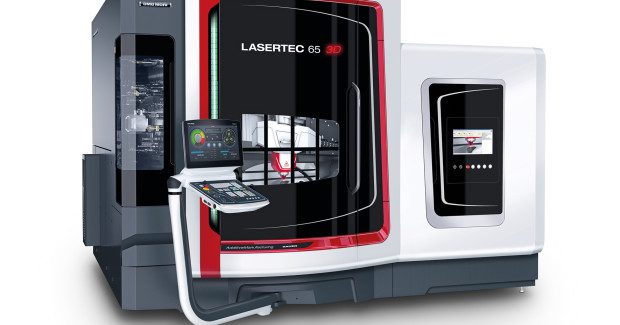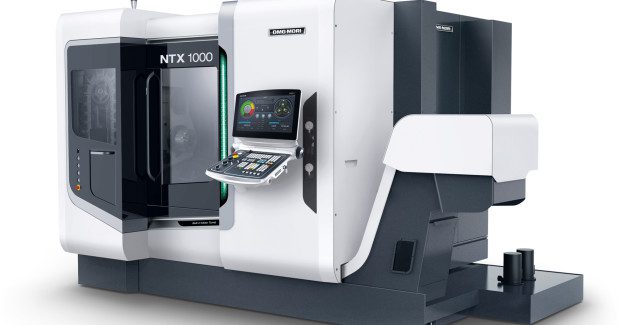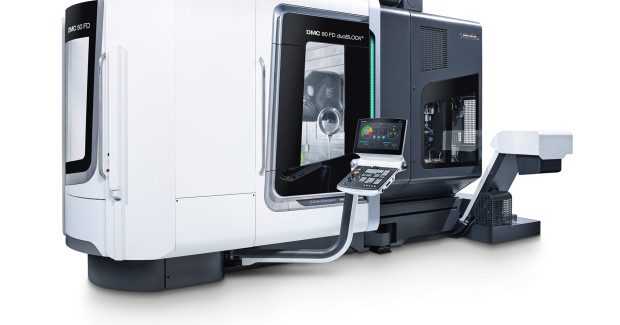Hybrid Manufacturing of 3D Aerospace Parts To Finish Quality
The LASERTEC 65 3D hybrid from DMG MORI is ideal for complete machining of complex components, plus partial or complete coatings for mold making, mechanical and medical engineering.
Posted: February 26, 2016
The market for additive processes has been growing rapidly. However, up to now these processes have been restricted to the production of prototypes and small parts, which could not otherwise have been manufactured using conventional methods. With the combination of the two processes, metal deposition / additive manufacturing (AM) and metal removal / subtractive manufacturing (SM) on one machine, additive technology complements and enhances traditional machining methods.
To enable generative manufacturing, the LASERTEC 65 3D from DMG MORI (Hoffman Estates, IL) is equipped with a 2 kW diode laser for laser deposition welding, while the fully fledged 5-axis milling machine in robust monoBLOCK® design makes it possible to carry out highly accurate milling operations. “Thanks to the fully automatic changeover between milling and laser operation, the LASERTEC 65 3D is suitable for the complete machining of complex components with undercuts as well as for repair work and the application of partial or complete coatings for mold making and mechanical engineerinhttps://youtu.be/k3y8PxgZ1IEg or even medical engineering,” explains Friedemann Lell, the sales director at Sauer Lasertec (a DMG MORI company).
In contrast to laser melting in a powder bed, laser deposition welding enables large parts to be manufactured using a metal powder nozzle. With a deposition rate of up to 1 kg/hr (2.2 lb/hr), this process is up to ten times faster than the laser generation of parts in a powder bed. The combination with milling opens up completely new applications. The component can be built up in several steps, whereby milling can be interspersed with deposition welding in order to allow areas, which the cutter would no longer be able to reach when the component is finished due to component geometry, to be machined to final accuracy.
The hybrid machine combines the advantages of milling, such as high precision and surface quality, with the flexibility and high deposition rate of powder deposition welding. “In the case of integral components, where today 95 percent of the material HSK toolholder is removed by milling, with additive processes material is only built up where it is needed. This leads to significant savings in raw materials and costs,” notes Lell. The laser, complete with powder deposition head, is fitted into the HSK toolholder of the milling spindle. It can be automatically parked in a secure docking station while milling operations are being carried out on the machine. The machine and process are operated and controlled by means of the new 21.5 in ERGOline® control with CELOS and Operate 4.5 on Siemens 840D solutionline.
Using a laser diode, the metal powder is deposited in layers onto a base material and fused without pores or cracks. The metal powder forms a high-strength welded bond with the surface. A coaxial inert gas prevents oxidation during the build-up process. After cooling, a layer of metal forms which can then be mechanically machined. As laser deposition welding has long been established as a stand-alone technology, it is ideal for incorporation into high-quality CNC machines. “The combination of chip-removal and additive processes will become more important in the future as it opens up so many new options and advantages for the user,” says Lell.
One strength of this process is the option of successively building up layers of different materials. Wall thicknesses of 0.1 mm to 5 mm (0.004 in to 0.2 in) are possible depending on the laser and nozzle geometry. Even complex 3D contours can be generated without any support structures. The individual layers can then be accurately machined before the areas become inaccessible to a cutter or other tools due to component geometry. The combination of the two processes is a sensible choice for repair work and the production of tools and molds. However, it also offers many interesting options for lightweight components, prototypes or small series production – particularly in the large-part manufacturing sector where other additive manufacturing processes cannot be used due to space limitations.
Large machines, such as those used for machining bulky components in the aerospace industry, tend to be expensive. The possibility of carrying out roughing, deposition and finishing on a single machine therefore represents a financially advantageous solution for the customer. Another example is the energy and oil industry where components often have to be coated with corrosion-resistant alloys to protect them against wear. Deposition welding provides protection for products such as pipes, fittings, flanges and special constructions which are used in aggressive environments. With a hybrid solution, machining of the base material, coating and finishing can be carried out on one machine. This results in cost savings and a reduction in throughput times.
DMG MORI also offers the compact NTX 1000 2nd Generation turn/mill machining center that has a B-axis and lower disk turret for up to 6-sided and 5-axis complete machining of smaller aerospace parts. Even with the smallest footprint in its class, this machining center offers a surprisingly spacious work area for complex turning and milling operations. The tool spindle, for example, can handle a maximum turning diameter of 430 mm (16.9 in) with a swing diameter of 680 mm (26.8 in). The turning length is 800 mm (31.5 in) and the tool spindle travel 455 mm x ±105 mm x 800 mm (17.9 in x ±4.1 in x 31.5 in) (X / Y / Z). The Z-axis travel that has been extended to 800 mm (31.5 in) and the 210 mm (8.3 in) Y-axis for off-center machining are two features that rank as unique selling points on the competitive market of turn/mill centers.
The high performance B-axis has a swivel range of ±120 deg and Capto C5 (HSK-A50) interface as the basis of complex 5-axis simultaneous machining, with speeds of up to 12,000 rpm in the standard version (20,000 rpm optional). The lower BMT® turret (Built-in Motor Turret), as a second tool holder with directly driven tools, enables a multitude of productivity-enhancing possibilities, such as 4-axis machining or parallel machining on the main and counter spindles. The shorter per piece times made possible by parallel machining with two tool holders makes the NTX 1000 2nd Generation ideal for turnkey solutions in serial production. This also applies to other possible uses of the second tool holder, such as mounting a life center on the turret to support long workpieces during machining.
The NTX 1000 2nd Generation integrates unique original technologies, such as DDM® (Direct Drive in the B-axis) and BMT (the high-end turret with integrated directly driven tools for unbeatable milling results). It also impresses with extensive cooling measures for preventing thermal impacts from compromising machining precision: first and foremost, the cooling of the ball screws (including nuts), and the turning and milling spindles of the B-axis and the BMT turret. The NTX 1000 2nd Generation is available as an extensive high-tech modular system with different expansion options, ranging from a chuck lathe with B-axis to a version with additional tailstock/tail spindle combination, up to expansion options with counter spindle and additional lower turret. Diverse automation options include gantry loaders or robotic handling.
All of this performance capability is rounded off with ERGOline control and CELOS for the fastest way from the idea to the finished product. The control technology uses the Operate 4.5 platform with Siemens 840D solutionline or FANUC 31iB. Other features include:
- Up to ten directly driven tools with speeds of 10,000 rpm on the BMT turret.
- Highest and consistent accuracy without compensation due to thermal control and roller guides for 50 percent lower backlash.
- Patented thermally symmetrical headstock cooling system.
- Maximum precision of 2 µm (0.00008 in) straightness in the Y-axis.
- Smallest footprint in its class at 9.9 m2 (106.6 sq ft)
DMG MORI also offers the 4th generation DMC 80 FD duoBLOCK® universal machining center with a newly developed B-axis milling head that has a swivel range of 210 deg, with a swivel of 30 deg in the negative direction. The larger axis bearing results in a 20 percent increase in rigidity. The extended swivel range and reduced interference contour in conjunction with the cable conduit integrated into the housing enable an even wider range of customer-specific complete machining operations to be carried out. Idle times are reduced thanks to shortened B-axis movements, and the extended life of the integral cables has a positive effect on high machine availability.
Currently, only DMG MORI is able to supply the unique combination of a redesigned B-axis with an even stiffer and more accurate milling/turning table with pallet system. In the DMC 80 FD duoBLOCK, this is also fitted with larger bearings and improved clamping. In the 4th generation, the duoBLOCK machine has been made even more stable thanks to 30 percent greater rigidity. With a larger work area of 0.715 dm3 (43.6 in3) and a Z-axis traverse of 850 mm (33.5 in), the DMC 80 FD duoBLOCK has increased overall rigidity despite a reduced footprint. This is based on structural optimization of the reinforced, in some areas wider, machine beds and columns made of high-quality castings (GGG 60). The supporting surfaces of the inherently rigid machine beds have also been enlarged, with stronger 55 mm (2.2 in) linear guides fitted on the Y-axis, and 50 mm (2.0 in) diameter ballscrew drives incorporated.
These measures, and the larger bearings in the B-axis and C-axis, have increased the overall rigidity in the 4th generation DMC 80 FD duoBLOCK by about 20 percent, making it possible for heavy duty milling to be carried out with the new powerMASTER 1000 spindle and HSK 100 toolholder interface in the B-axis. The spindle has a power rating of 77 kW (103.2 hp) and maximum speed of 9,000 rpm, and the torque is 1,000 Nm (737.6 ft-lb). The B-axis provides a 120 percent power increase compared to previous motor spindles and offers milling performance and chipping power in a completely new dimension. In comparison with the competition, these 4th generation universal milling centers achieve 75 percent greater metal removal rates during 5-axis milling.
Motor spindles with the HSK 63 tool interface up to 18,000 rpm for high-speed cutting (HSC machining) are another option for the duoBLOCK. Torquemaster gear-driven spindles with 1,053 Nm or 1,424 Nm (776.7 ft-lb or 1,050.3 ft-lb at 8,000 rpm and 37 kW or 44 kW (49.6 hp or 60.0 hp) for HSK 100 can be used in the machines when carrying out high-performance cutting operations (HPC machining).
An almost constant overall machine temperature is achieved during chip removal by structurally strengthened and thermo-symmetrical machine design, along with additional cooling channels in the machine bed and column, together with the liquid cooling of the feed drives on all linear axes, including the rotary table with C-axis motor, reliably dissipate the heat produced during chip removal. The previous cooling measures in the whole B-axis/milling head area and in the electrical cabinet have been adapted to suit the re-engineered machine structure. Despite the increase in power, all of these coordinated measures lead to a balanced temperature level in the machines. Standard electronic compensation devices eliminate the residual displacement caused by temperature or the effects of static or dynamic forces. The devices are supplemented by the effective use of the Spindle Growth Sensor (SGS) to prevent axial spindle displacement.
The option of careful temperature control of the coolant during machining is also recommended. The combination of all these measures leads to 30 percent greater workpiece accuracy when milling or during mill/turn machining with the 4th generation duoBLOCK® universal machining centers.
Achievable production times and idle time on the DMC 80 FD duoBLOCK have been optimized by redesigning the tool and workpiece changeover in parallel with production on the 4th generation duoBLOCK machines. Space-saving wheel magazines with 123 tool pockets reduce the space required by approximately 40 percent. The parallel arrangement of up to four wheel magazines with a total capacity of 243 tool pockets satisfies the increasing number of possible applications of the 4th generation universal machining centers and the upward trend in process automation. Short traverse distances and cam-controlled changers enable short times to be achieved when changing and presenting tools during production.
Idle time and the pallet changer have been improved by increasing the table speed of the 4th axis to 40 rpm rapid traverse and re-engineering the sequence. Additional devices for an enhanced process automation can be selected from the DECKEL MAHO modular system and connected accordingly. The same applies to the systems from our proven external partners. The use of pallet magazines, gantry loaders and robots, as well as the integration of the universal machining centers into flexible manufacturing systems, enables unattended automatic operation to be carried out.
The improved machine temperature control in the 4th generation machines increases the cooling unit energy requirement. Only highly efficient, energy-saving cooling units with power adjusted automatically to the machine cooling requirements are used in the 4th generation duoBLOCK. For example, the 80 bar (1160.3 psi) coolant pump is equipped with a speed controller to significantly reduce energy losses that prevent unnecessary heating of the coolant. The continuous power display on the CELOS interface indicates the current energy being used to the operator and analyzes the consumption at a specific point in time. Appropriate responses can lead to further energy savings.
The larger work area with longer vertical travel of 850 mm (33.5 in) is easily accessible from the side and from above. Despite a larger work area, the footprint has been reduced to 21.4 m2 (230.4 sq ft). The user-friendly ergonomics of the machine have been further improved and are reflected in the easily accessible setup station. These prerequisites are very important for effective workpiece fixturing and for work area visibility to observe the machining process. Automation devices external to the machine can also be readily connected to the enclosures by means of suitable interfaces.
The DMC 80 FD duoBLOCK uses CELOS with a 21.5 in ERGOline panel and Siemens control. CELOS APPs provide the user with integrated management, documentation and visualization of order, process and machine data. CELOS is compatible with MRP and ERP systems, can be networked with CAD/CAM applications, and is ready for future, trendsetting CELOS APP extensions. The standard machine comes equipped with Operate 4.5 on a Siemens 840D solutionline including a 19 in ERGOline panel.
DMG MORI, 2400 Huntington Boulevard, Hoffman Estates, IL 60192, 847-593-5400, Fax: 847-593-5433, www.dmgmori.com.













